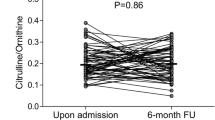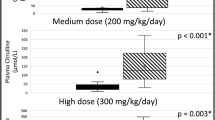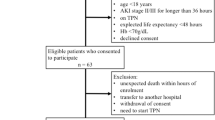Abstract
Objective: In physiological conditions, the liver plays an important role in the regulation of plasma arginine concentrations by taking up large amounts of arginine from the hepatic circulation. When hepatic failure is present, arginine metabolism may be disturbed. Therefore, we hypothesized high arginine plasma concentrations in critically ill patients suffering from hepatic failure.
Design: We prospectively collected blood samples from a cross-section of intensive care unit patients.
Setting: Surgical intensive care unit of a Dutch university medical center.
Subjects: A total of 52 critically ill patients with clinical evidence of dysfunction of more than two organs were recruited.
Measurements: Plasma arginine concentrations were determined by HPLC. We identified correlations of arginine concentrations with organ failure scores and laboratory variables by univariate and multiple regression analyses.
Results: High plasma arginine concentrations were found in critically ill patients developing organ failure. Patients who were in the highest quartile of plasma arginine concentrations had significantly lower fibrinogen concentrations, higher lactic acid concentrations, and longer prothrombin time. Stepwise multiple regression analysis showed that concentrations of arginine were independently associated with the presence of hepatic failure (P=0.03) and renal failure (P=0.048). In addition, lactic acid proved to be an independent determinant of plasma arginine concentration (P=0.014).
Conclusions: Critically ill patients who suffer from hepatic failure have elevated plasma arginine concentrations. Additional arginine in the treatment of these patients can be harmful, and therefore should not be used as a standard nutritional regimen until further evaluation.
This is a preview of subscription content, access via your institution
Access options
Subscribe to this journal
Receive 12 print issues and online access
$259.00 per year
only $21.58 per issue
Buy this article
- Purchase on Springer Link
- Instant access to full article PDF
Prices may be subject to local taxes which are calculated during checkout
Similar content being viewed by others
References
Alberti KG, Johnston HH, Lauler DP & Jagger PI (1967): Effect of arginine on electrolyte metabolism in man. Clin. Res. 15, 476 (abstract).
Barbul A, Fishel RS, Shimazu S, Wasserkrug HL, Yoshimura NN, Tao RC & Efron G (1985): Intravenous hyperalimentation with high arginine levels improves wound healing and immune function. J. Surg. Res. 38, 328–334.
Barbul A, Lazarou SA, Efron DT, Wasserkrug HL & Efron G (1990): Arginine enhances wound healing and lymphocyte immune responses in humans. Surgery 108, 331–336.
Barbul A, Wasserkrug HL, Yoshimura N, Tao R & Efron G (1984): High arginine levels in intravenous hyperalimentation abrogate post-traumatic immune suppression. J. Surg. Res. 36, 620–624.
Bertolini G, Iapichino G, Radrizzani D, Facchini R, Simini B, Bruzzone P, Zanforlin G & Tognoni G (2003): Early enteral immunonutrition in patients with severe sepsis. Results of an interim analysis of a randomized multicentre clinical trial. Intensive Care Med. 29, 834–840.
Borsook H & Dubnoff JW (1941): The conversion of citrulline to arginine in kidney. J. Biol. Chem. 140, 717–738.
Bower RH, Cerra FB, Bershadsky B, Licari JJ, Hoyt DB, Jensen GL, van Buren CT, Rothkopf MM, Daly JM & Adelsberg BR (1995): Early enteral administration of a formula (Impact) supplemented with arginine, nucleotides, and fish oil in intensive care unit patients: results of a multicenter, prospective, randomized, clinical trial. Crit. Care Med. 23, 436–449.
Brusilow SW & Horwich AL (1989): Urea cycle enzymes. In The Metabolic Basis of Inherited Disease, 6th Edition, eds CR Scriver, AL Beaudet, WS Sly & D Valle, pp 629–663. St Louis: McGraw-Hill.
Bushinsky DA & Gennari FJ (1978): Life-threatening hyperkalemia induced by arginine. Ann. Intern. Med. 89, 632–634.
Closs EI, Scheld JS, Sharafi M & Forstermann U (2000): Substrate supply for nitric-oxide synthase in macrophages and endothelial cells: role of cationic amino acid transporters. Mol. Pharmacol. 57, 68–74.
Creager MA, Gallagher SJ, Girerd XJ, Coleman SM, Dzau VJ & Cooke JP (1992): L-Arginine improves endothelium-dependent vasodilation in hypercholesterolemic humans. J. Clin. Invest. 90, 1248–1253.
Cui XL, Iwasa M, Iwasa Y & Ogoshi S (2000): Arginine-supplemented diet decreases expression of inflammatory cytokines and improves survival in burned rats. JPEN J. Parenter. Enteral Nutr. 24, 89–96.
Dent DL, Heyland DK, Levy H, Martindale R, Tayek J, Schloerb P & Kelley MJ (2003): Immunonutrition may increase mortality in critically ill patients with pneumonia: results of a randomized trial. Crit. Care Med. 30, A17 (abstract).
Freund HR, Ryan Jr JA & Fischer JE (1978): Amino acid derangements in patients with sepsis: treatment with branched chain amino acid rich infusions. Ann. Surg. 188, 423–430.
Hattori Y, Kasai K & Gross SS (1999): Cationic amino acid transporter gene expression in cultured vascular smooth muscle cells and in rats. Am. J. Physiol. 276, H2020–H2028.
Hertz P & Richardson JA (1972): Arginine-induced hyperkalemia in renal failure patients. Arch. Intern. Med. 130, 778–780.
Heyland DK, Novak F, Drover JW, Jain M, Su X & Suchner U (2001): Should immunonutrition become routine in critically ill patients? A systematic review of the evidence. JAMA 286, 944–953.
Heyland DK & Samis A (2003): Does immunonutrition in patients with sepsis do more harm than good? Intensive Care Med. 29, 669–671.
Houdijk AP, Rijnsburger ER, Jansen J, Wesdorp RI, Weiss JK, McCamish MA, Teerlink T, Meuwissen SG, Haarman HJ, Thijs LG & van Leeuwen PA (1998): Randomized trial of glutamine-enriched enteral nutrition on infectious morbidity in patients with multiple trauma. Lancet 352, 772–776.
Houdijk AP, Teerlink T, Visser JJ, van Lambalgen AA & van Leeuwen PA (1997): Arginine deficiency in bile duct-ligated rats after surgery: the role of plasma arginase and gut endotoxin restriction. Gastroenterology 113, 1375–1383.
Jackson MJ, Beaudet AL & O’Brien WE (1986): Mammalian urea cycle enzymes. Annu. Rev. Genet. 20, 431–464.
Lee J, Ryu H, Ferrante RJ, Morris Jr SM & Ratan RR (2003): Translational control of inducible nitric oxide synthase expression by arginine can explain the arginine paradox. Proc. Natl. Acad. Sci. 100, 4843–4848.
Lorente JA, Delgado MA, Tejedor C, Mon E, Hervas M, Pascual T, Fernandez-Segoviano P, Rieppi G, Soler A, Ayuso D & Esteban A (1999): Modulation of systemic hemodynamics by exogenous L-arginine in normal and bacteremic sheep. Crit. Care Med. 27, 2474–2479.
Massara F, Martelli S, Cagliero E, Camanni F & Molinatti GM (1980): The hypophosphatemic and hyperkalemic effect of arginine in man. J. Endocrinol. Invest. 3, 177–180.
Mudge GH (1980): Agents affecting volume and composition of body fluids. In The Pharmacologic Basis of Therapeutics, 6th Edition, eds LS Goodman & AG Gilman, pp 892–915. New York: Macmillan.
Naini AB, Dickerson JW & Brown MM (1988): Preoperative and postoperative levels of plasma protein and amino acid in esophageal and lung cancer patients. Cancer 62, 355–360.
Nakaki T, Hishikawa K, Suzuki H, Saruta T & Kato R (1990): L-arginine-induced hypotension. Lancet 336, 696.
Nelson LD (1998): Death knell for parenteral nutrition? Crit. Care Med. 26, 4.
Nijveldt RJ, Prins HA, Siroen MP, Rauwerda JA, Teerlink T & van Leeuwen PA (2000): Low arginine plasma levels in patients after thoracoabdominal aortic surgery. Eur. J. Clin. Nutr. 54, 615–617.
Palmer RM, Ashton DS & Moncada S (1988): Vascular endothelial cells synthesize nitric oxide from L-arginine. Nature 333, 664–666.
Prins HA, Houdijk AP, Wiezer MJ, Teerlink T, van Lambalgen AA, Thijs LG & van Leeuwen PA (2000a): The effect of mild endotoxemia during low arginine plasma levels on organ blood flow in rats. Crit. Care Med. 28, 1991–1997.
Prins HA, Meijer C, Nijveldt RJ, Wiezer MJ & van Leeuwen PA (2000b): High plasma levels of arginine and liver arginase in Kupffer-cell-depleted rats after partial hepatectomy. J. Hepatol. 32, 399–405.
Prins HA, Nijveldt RJ, Gasselt DV, van Kemenade F, Teerlink T, van Lambalgen AA, Rauwerda JA & van Leeuwen PA (2002): The flux of arginine after ischemia–reperfusion in the rat kidney. Kidney Int. 62, 86–93.
Reynolds JV, Daly JM, Zhang S, Evantash E, Shou J, Sigal R & Ziegler MM (1988): Immunomodulatory mechanisms of arginine. Surgery 104, 142–151.
Roth E, Steininger R, Winkler S, Langle F, Grunberger T, Fugger R & Muhlbacher F (1994): L-arginine deficiency after liver transplantation as an effect of arginase efflux from the graft. Influence on nitric oxide metabolism. Transplantation 57, 665–669.
Takala J, Ruokonen E, Webster NR, Nielsen MS, Zandstra DF, Vundelinckx G & Hinds CJ (1999): Increased mortality associated with growth hormone treatment in critically ill adults. N. Engl. J. Med. 341, 785–792.
Teerlink T, Nijveldt RJ, de Jong S & van Leeuwen PA (2002): Determination of arginine, asymmetric dimethylarginine, and symmetric dimethylarginine in human plasma and other biological samples by high-performance liquid chromatography. Anal. Biochem. 303, 131–137.
Tizianello A, De Ferrari G, Garibotto G, Gurreri G & Robaudo C (1980): Renal metabolism of amino acids and ammonia in subjects with normal renal function and in patients with chronic renal insufficiency. J. Clin. Invest. 65, 1162–1173.
Vincent JL, Moreno R, Takala J, Willatts S, De Mendonca A, Bruining H, Reinhart CK, Suter PM & Thijs LG (1996): The SOFA (Sepsis-related Organ Failure Assessment) score to describe organ dysfunction/failure. On behalf of the working group on sepsis-related problems of the European Society of Intensive Care Medicine. Intensive Care Med. 22, 707–710.
Wiebke EA, Grieshop NA, Sidner RA, Howard TJ & Yang S (1997): Effects of L-arginine supplementation on human lymphocyte proliferation in response to nonspecific and alloantigenic stimulation. J. Surg. Res. 70, 89–94.
Wu G & Morris Jr SM (1998): Arginine metabolism: nitric oxide and beyond. Biochem. J. 336, 1–17.
Yu YM, Ryan CM, Burke JF, Tompkins RG & Young VR (1995): Relations among arginine, citrulline, ornithine, and leucine kinetics in adult burn patients. Am. J. Clin. Nutr. 62, 960–968.
Acknowledgements
We thank W. in ‘t Veld for collecting plasma samples of the studied patients.
Author information
Authors and Affiliations
Contributions
Contributors: RN managed the data and wrote the first drafts. MS contributed in writing and editing of the manuscript. BvdH judged on the suitability for inclusion of the patients and reviewed the manuscript. TT analysed the blood samples and reviewed the manuscript. HP and AG reviewed the manuscript. PvL supervised the project.
Grant/fellowship: RJ Nijveldt, MD, is a recipient of a fellowship from the Council for Medical Research of the Netherlands Organisation for Scientific Research
Corresponding author
Rights and permissions
About this article
Cite this article
Nijveldt, R., Siroen, M., van der Hoven, B. et al. High plasma arginine concentrations in critically ill patients suffering from hepatic failure. Eur J Clin Nutr 58, 587–593 (2004). https://doi.org/10.1038/sj.ejcn.1601851
Received:
Revised:
Accepted:
Published:
Issue Date:
DOI: https://doi.org/10.1038/sj.ejcn.1601851
Keywords
This article is cited by
-
Factors that influence the quality of metabolomics data in in vitro cell toxicity studies: a systematic survey
Scientific Reports (2021)
-
Amperometric L-arginine biosensor based on a novel recombinant arginine deiminase
Microchimica Acta (2017)



